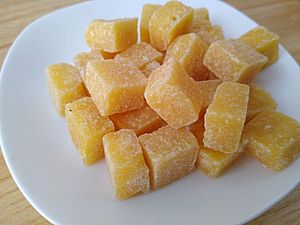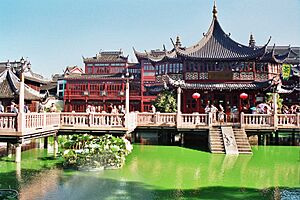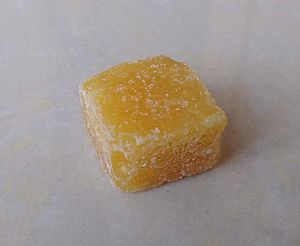Pear-syrup candy facts for kids
 |
|
| Alternative names | Ligaotang Liqingtang |
|---|---|
| Place of origin | China |
| Region or state | Jiangnan |
| Created by | Wei Zheng |
| Main ingredients | Pear, honey, rock candy |
Pear-syrup candy, also known as lígāotáng (梨膏糖) or líqīnggāo (梨清膏), is a special sweet treat from the Jiangnan area of China. It's not just a candy; it was also used as a traditional Chinese medicine! This candy is clear and shiny. People used to believe it could help with coughs, reduce mucus, and make you feel hungrier. Its main ingredients are pear juice, honey, and different kinds of herbs.
Today, doctors don't often use pear-syrup candy for coughs anymore. Instead, it has become a popular snack and a special souvenir. It's a big part of the culture in the Jiangnan region.
Contents
History of Pear-Syrup Candy
How Pear-Syrup Candy Started
The story of pear-syrup candy goes way back to the year 634, during the Tang Dynasty. Legend says that Wei Zheng, a famous government official, had a mother who suffered from a bad cough. The doctors from the palace tried to help her, but their medicines were too bitter. Because of this, Wei Zheng's mother didn't take her medicine regularly, and she didn't get better quickly.
So, Wei Zheng decided to create his own medicine. He mixed special herbs like almond, chuanbei, tuckahoe, and juhong (red tangerine peel). He added these to pear syrup and cooked it all down into a thick paste. His mother tried this new medicine, and she got well very fast! After that, Wei Zheng shared his recipe with everyone. Soon, both rich and ordinary people started making this special candy, and the recipe spread far and wide.
Pear-Syrup Candy Grows Popular
During the Northern Song Dynasty (960-1127), making and selling pear-syrup candy became a big business. In the city of Luoyang, there were many shops selling it, and the way they made it was very advanced.
Later, around 1127, many skilled candy makers moved to the south of China. They traveled through Yangzhou and finally settled in Hangzhou, which was the capital city at the time. This is how pear-syrup candy became popular in cities like Suzhou, Wuxi, and Changzhou, and it has stayed a favorite treat in the Jiangnan area ever since.
Modern Pear-Syrup Candy
In more recent times, pear-syrup candy developed different styles, like Shanghai style, Suzhou style, Hangzhou style, Yangzhou style, and Ningbo style. These different types became very popular in Shanghai. The pear-syrup candy business really grew in Shanghai in the mid-1800s.
In 1855, the first pear-candy shop, Zhupinzhai, opened in Chenghuang Miao in Shanghai. Then, in 1882, Yongsheng Tang opened, followed by Deshengtang in 1904. These three shops were the most important ones. They competed with each other, which helped the pear-syrup candy industry grow very quickly and reach its best time.
These shops made their candies by hand, using their own secret recipes. They believed that their candy was both a food and a medicine. Besides the original medicinal pear-syrup candy, they also made new kinds with mint, pine nut, dried meat floss, or rose flavors. These were very popular with people who enjoyed tea and listened to storytellers.
In 1956, the Chinese government started working with private companies. Zhupinzhai, Yongshengtang, and Deshengtang joined together to form the Shanghai Pear-Syrup Candy Food Factory. This factory became the main producer of pear-syrup candy in China. Today, it's part of a larger company called Yuyuan Tourist Mart.
Modern factories now make two types of pear-syrup candy:
- Food-oriented candy: This type is made with Chinese herbs and natural ingredients. It comes in many flavors like mint, Chinese cymbidium, shrimp, walnut, kumquat, dried meat floss, almond, ginkgo, ham, peanut, pine nut, rose, sweet-scented osmanthus, and sweet bean paste.
- Medicine-oriented candy: This type is approved by the Ministry of Health of the People's Republic of China (MOH) to be used as medicine. These candies, with ingredients like Sichuan fritillary bulbs, can help with coughs, bronchitis, asthma, and other sicknesses.
What Makes Pear-Syrup Candy Special?
Pear-syrup candy contains important tiny nutrients that our bodies need, like calcium, potassium, and iron. It also has vitamins such as carotene, thiamine, riboflavin, folic acid, and ascorbic acid.
Traditional pear-syrup candy is made from loquat or fresh pear. It also includes herbs like almond, jiegeng (Chinese bellflower), tuckahoe, banxia, donghua (coltsfoot), qianhu (hogfennel root), juhong (red tangerine peel), beimu (Fritillaria thunbergii), and sugar. Some recipes also add pangdahai and honeysuckle. These ingredients are thought to help clean and soothe the throat, reduce coughing, and clear mucus.
Today, the medical benefits of modern pear-syrup candy are less emphasized. Only factories with a long history that are approved by the MOH can make medicinal pear-syrup candy. Most other factories only produce the food-oriented type. The government has rules that say food and medicine must be sold separately. They also advise manufacturers not to add medical ingredients to food, even if those ingredients have been used in traditional foods.
For example, the Law of Food Safety of People's Republic of China says that food makers cannot add medicines to food. When labeling pear-syrup candy, it's not allowed to say that it can cure coughs or reduce mucus. Also, terms like 'dietetic food' or 'health food' cannot be used.
Cultural Influences of Pear-Syrup Candy
Candy Making as a Performance
In the past, making pear-syrup candy was sometimes a performance! There were two main types of performances:
- Wenmai: This was an artistic performance, sometimes called Cuomu. It often involved singing local songs. This attracted crowds and helped people understand how the candy was made. Wenmai became a special way for sellers in Shanghai to sell their candy.
- Wumai: This was more like a martial arts performance, also called "Luobang." It was a way of selling candy through rapping. Vendors would rap and sell their candies in different dialects, which made them very popular. They would rap about new things they had to sell as they moved from street to street.
The "Xiaorehun" Rap
Among the Wumai vendors, Chen Changsheng, also known as Xiao Deli, was the most famous. He was seen as the best pear-syrup candy seller in Suzhou. Later, a man named Du Baolin created something new based on Chen's style. He added jokes about politics and made fun of officials in his raps. To avoid getting into trouble with the government, he called himself "Xiaorehun." He claimed that everything he said was just nonsense, so officials shouldn't worry about it.
Du Baolin's "Xiaorehun" rap became very popular in Hangzhou. Later, he moved to Shanghai to find new opportunities and became a famous comedian in the 1920s. Because of him, "Xiaorehun" became another name for pear-syrup candy.
In 1958, Wu Jingshou (Xiao Mingli) and Bao Yunfei (Xiao Delin) started a Rap and Candy-selling Cooperation in Changzhou. This helped spread the "Xiaorehun" culture in Suzhou. Wumai in Yangzhou was also interesting. Usually, two people would work together, pushing wheelbarrows and walking along the streets. They sold candies in busy places and sang Xiaodiao (Yangzhou folk songs) to attract customers. These songs were clear and easy to understand, often making the audience laugh.
Some experts believe that "Xiaorehun" played a big part in creating and developing Shanghai Dujiaoxi, which is a type of "funny drama." Also, the fact that "Xiaorehun" artists were brave enough to share their ideas about politics openly shows how people were starting to fight for their right to speak freely.
A Special Cultural Heritage
The performance of "Xiaorehun" and the way pear-syrup candy is made have been recognized as important cultural heritage. Shanghai City, Jiangsu Province, and Zhejiang Province have all listed them in their special directories of nonmaterial cultural heritage. This means they are considered valuable traditions that should be preserved.
For example, Shanghai government listed the making process of pear-syrup candy as a special cultural heritage. Jiangsu Province listed both the Changzhou "Xiaorehun" rap and the Changzhou style of making pear-syrup candy. Zhejiang Province also listed "Xiaorehun" as a top cultural heritage.
Famous Brands
Some well-known Chinese brands of pear-syrup candy today include Caizhi Zhai and City God Temple of Shanghai. These are produced by the Shanghai Pear-Syrup Candy Food Factory.



